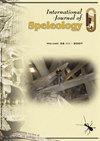风力驱动和烟囱效应洞穴通风的相对重要性:Postojna洞穴的观测(斯洛文尼亚)
IF 1.3
4区 地球科学
Q3 GEOSCIENCES, MULTIDISCIPLINARY
引用次数: 5
摘要
密度驱动的烟囱效应气流是洞穴通风最常见的形式,允许外部和岩溶地下之间的气体交换。然而,洞穴通风也可以由其他机制驱动,即风。我们通过在斯洛文尼亚Postojna洞穴的观测,讨论了风力通风的机制和动力学。我们展示了由烟囱效应驱动的季节性气流模式是如何被外部风大幅改变的。不规则地形上的气流形成了近地表空气压力的变化,从而形成了不同位置洞穴入口之间的压力差。这些压差取决于风速和风向,以及它们与地表地形和洞穴入口位置的关系。风的作用方向可以与烟囱效应相同或相反,并且可以增强、减少甚至逆转密度驱动气流的方向。为了检验风驱动流动的可能性,我们使用计算流体动力学模型来计算Postojna洞穴上空的风压场,以及不同风速和风向配置下选定点之间的压差。我们将这些值与从洞穴中的气流测量和简单的理论考虑中获得的值进行了比较。尽管方法简单,洞穴系统复杂,但比较结果显示出令人满意的一致性。这允许对风压对地下通风的相对重要性进行更全面的评估。我们确信,这个例子并不是唯一的,需要在其他地方考虑风驱动效应,以更好地了解洞穴气候、空气成分或滴水地球化学的动力学。本文章由计算机程序翻译,如有差异,请以英文原文为准。
The relative importance of wind-driven and chimney effect cave ventilation: Observations in Postojna Cave (Slovenia)
Density-driven chimney effect airflow is the most common form of cave ventilation, allowing gas exchange between the outside and the karst subsurface. However, cave ventilation can also be driven by other mechanisms, namely winds. We discuss the mechanism and dynamics of wind-driven ventilation using observations in Postojna Cave, Slovenia. We show how seasonal airflow patterns driven by the chimney effect are substantially modified by outside winds. Wind flow over irregular topography forms near-surface air pressure variations and thus pressure differences between cave entrances at different locations. These pressure differences depend on wind speed and direction and their relationship to surface topography and the location of cave entrances. Winds can act in the same or opposite direction as the chimney effect and can either enhance, diminish or even reverse the direction of the density-driven airflows. To examine the possibility of wind-driven flow, we used a computational fluid dynamics model to calculate the wind pressure field over Postojna Cave and the pressure differences between selected points for different configurations of wind speed and direction. We compared these values with those obtained from airflow measurements in the cave and from simple theoretical considerations. Despite the simplicity of the approach and the complexity of the cave system, the comparisons showed satisfactory agreement. This allowed a more general assessment of the relative importance of wind pressure for the subsurface ventilation. We are certain that this example is not unique and that the wind-driven effect needs to be considered elsewhere to provide better insights into the dynamics of cave climate, air composition or dripwater geochemistry.
求助全文
通过发布文献求助,成功后即可免费获取论文全文。
去求助
来源期刊

International Journal of Speleology
地学-地球科学综合
CiteScore
3.10
自引率
23.10%
发文量
12
审稿时长
>12 weeks
期刊介绍:
The International Journal of Speleology has the aim to get cave and karst science known to an increasing number of scientists and scholars. The journal therefore offers the opportunity to all scientists working in and on karst to publish their original research articles or their review papers in an open access, high quality peer reviewed scientific journal at no cost. The journal offers the authors online first, open access, a free PDF of their article, and a wide range of abstracting and indexing services.
 求助内容:
求助内容: 应助结果提醒方式:
应助结果提醒方式:


